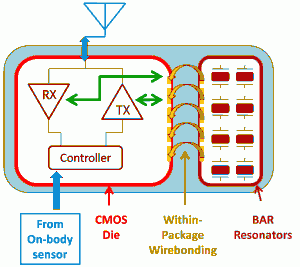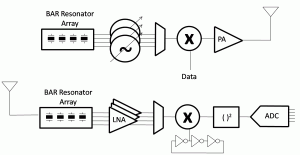Ultra-low-power Transceivers for Body-area Networks

Figure 1: The proposed prototype system. The entire system (minus the antenna) is in a single package, and internal wirebonds are used to connect the BAR die to the CMOS chip.
The rise of on-body medical monitoring devices has created a need to efficiently and securely transmit physiological information around the body. As opposed to wired-links, wireless Body-area Networks (BANs) provide a comfortable and unobtrusive communication medium for this information at the expense of energy and security. The principal challenge in radio design for BANs is a tight power budget. To address this issue, we are investigating new RF architectures that use high-Q MEMS devices [1] in low-power RF filters and oscillators for integration into a prototype transceiver system..
High-Q front-end filtering permits the exploration of unconventional ultra-low-power receiver architectures whereby downstream power requirements can be relaxed. The aim of this project is to integrate a high-Q Bulk Acoustic Resonator (BAR) device near the beginning of the receiver chain as an extremely narrowband channel-select filter. The signal can then undergo a power-efficient down-conversion followed by a simple energy-detection at an uncertain intermediary frequency [2].
For body-worn nodes, an RF transmission power of around -10 dBm is sufficient to cover short distances of 1-2 m. However, designing very efficient systems for such low RF output power is a challenge. Very high-Q resonators can be used as low-power local oscillators with excellent stability and precision [3], obviating the need for an energy-hungry PLL. Optimized push-pull amplifier strategies are also employed along with energy-efficient modulation schemes like BPSK and OOK. Pulse shaping, realized by modulating the matching network to the PA, is used to improve spectral usage and thus increase data-rates.
In both the transmit and receive paths, a variable center-frequency is required to utilize all channels within the 2.4 GHz ISM band. For this, our architecture utilizes multiple resonators spaced at different frequencies. The entire radio front-end (minus the antenna) can be integrated into a single-package prototype, and internal wirebonds can be used to stitch the resonators to the circuits.
References
- R. Marathe, A. Erbes, D. Weinstein, “RF-MEMS resonators for body-area network transceivers,” Massachusetts Institute of Technology, Cambridge, MA, MTL Annual Research Report, 2010. [↩]
- N. M. Pletcher, S. Gambini, and J. M. Rabaey, “A 2GHz 52 μW Wake-Up Receiver with -72dBm Sensitivity Using Uncertain-IF Architecture,” ISSCC 2008. Digest of Technical Papers, pp.524-633, 3-7 Feb. 2008. [↩]
- Y. H. Chee, A. M. Niknejad; and J. M. Rabaey, “A sub-100 μW 1.9-GHz CMOS oscillator using FBAR resonator,” Radio Frequency Integrated Circuits (RFIC) Symposium, 2005, pp. 123- 126, 12-14 Jun. 2005. [↩]
